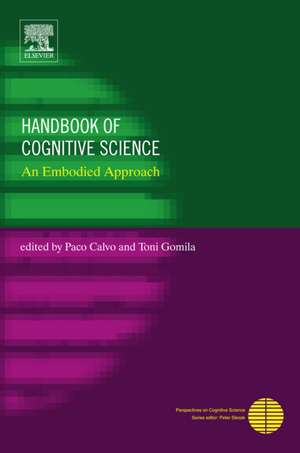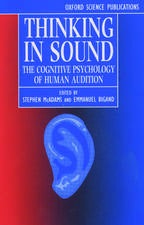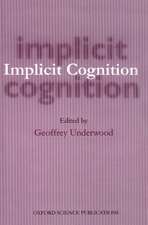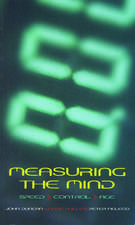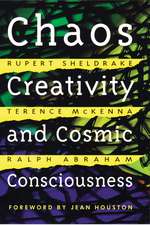Handbook of Cognitive Science: An Embodied Approach: Perspectives on Cognitive Science
Editat de Paco Calvo, Toni Gomilaen Limba Engleză Hardback – 5 noi 2008
Preț: 705.00 lei
Preț vechi: 774.73 lei
-9% Nou
Puncte Express: 1058
Preț estimativ în valută:
134.92€ • 146.50$ • 113.33£
134.92€ • 146.50$ • 113.33£
Carte tipărită la comandă
Livrare economică 16-30 aprilie
Preluare comenzi: 021 569.72.76
Specificații
ISBN-13: 9780080466163
ISBN-10: 0080466168
Pagini: 498
Ilustrații: illustrations
Dimensiuni: 152 x 229 x 28 mm
Greutate: 0.79 kg
Editura: ELSEVIER SCIENCE
Seria Perspectives on Cognitive Science
ISBN-10: 0080466168
Pagini: 498
Ilustrații: illustrations
Dimensiuni: 152 x 229 x 28 mm
Greutate: 0.79 kg
Editura: ELSEVIER SCIENCE
Seria Perspectives on Cognitive Science
Public țintă
Professionals, researchers, and advanced students in cognitive science, psychology, and philosophy.Cuprins
Contents
Preface
List of Contributors
1 Directions for an Embodied Cognitive Science: Toward an Integrated Approach
Cognitivism in a Blind Alley
Alternative Approaches to Cognitivism
Post-Cognitivism in the Making: Common Ground and Conceptual Issues
Scaling up: Higher Level Cognitive Processes
Acknowledgments
Section I The Interactive Architecture of Cognition: Conceptual Issues
2 Is Embodiment Necessary?
Critiques
Interactive Representation
What Kind of Embodiment?
Conclusion
3 Embodiment and Explanation
Three Threads
The Separability Thesis
Beyond Flesh-Eating Functionalism
Ada, Adder, and Odder
A Tension Revealed
Participant Machinery and Morphological Computation
Quantifying Embodiment
Conclusions
Acknowledgments
4 Can a Swarm be Embodied?
Introduction
Three Examples of Swarms
Artifi cial Swarms and Strong Embodiment
Is a Living Swarm an Embodied Entity?
Conclusion
Section II Robotics and Autonomous Agents
5 CajunBot: A Case Study in Embodied Cognition
Introduction
CajunBot and the DARPA Grand Challenge, 2005
CajunBot Sensor Systems
Path Planning
Steering Control
Simulations
CajunBot Performance and Results
Conclusion
Acknowledgments
6 The Dynamics of Brain–Body–Environment Systems: A Status Report
Introduction
Experimental Accomplishments
Theoretical Accomplishments
Outstanding Challenges
7 The Synthetic Approach to Embodied Cognition: A Primer
Introduction
Basics
Body Dynamics and Morphology
Information Self-Structuring
Learning and Development
Case Study 1: Embodied Categorization
Case Study 2: Application of Embodied Cognition to Prosthetics
Discussion: The Interaction of Physical and Information Processes
Conclusion
8 Animate Vision, Virtual Environments, and Neural Codes
Embodied Intelligence
An Avatar Control System Design
Summary: The Advantages of Embodied Cognition
Section III Perceiving and Acting
9 Ecological Psychology: Six Principles for an Embodied–Embedded Approach to Behavior
Ecological Principle I: Organism–Environment Systems are the Proper Units of Analysis
Ecological Principle II: Environmental Realities Should Be Defined at the Ecological Scale
Ecological Principle III: Behavior Is Emergent and Self-Organized
Ecological Principle IV: Perception and Action are Continuous and Cyclic
Ecological Principle V: Information Is Specificational
Ecological Principle VI: Perception Is of Affordances
Conclusion
10 Seeing What We Can Do: Insights into Vision and Action Through Observations of Natural Behavior
Introduction
Methods of Assessing Visual Processes in Isolation and in Concert
Isolating Visual Processes Within an Embodied Context
Trade-Offs Between Gaze and Working Memory Use
Bridging the Gap Between Laboratory Experiments and Natural Behavior
Future Directions of Research in Embodied Visual Cognition
11 Why We Don’t Mind to be Inconsistent
Introduction
Detecting Attributes
Spatial Perception
Inconsistent Action
Combining Information
Conscious Perception
Section IV A Dynamic Brain
12 Neuronal and Cortical Dynamical Mechanisms Underlying Brain Functions
Introduction
How to Build a Suitable Neuronal Model for a Psychological Experiment
Calculating the f MRI Signal for an Example Set Shifting Model
Response Times and Error Rates in an Example Set Shifting Task
Summary and Back to “color phi
13 Dynamic Field Theory as a Framework for Understanding Embodied Cognition
Dynamical Systems
Dynamic Neural Fields and Peaks as Units of Representation
Interactions Between Multiple Activation Peaks
Preshape in Dynamic Neural Fields
Categorical Behavior from Continuous Representations
Embodying Dynamic Neural Fields on Autonomous Robots
Conclusions
14 A Lazy Brain? Embodied Embedded Cognition and Cognitive Neuroscience
Introduction
Overview
The Computational Unfeasibility of a Brain in Complete Control
Ignorantly Successful in a User-Friendly Environment
Generating Research Questions for Cognitive Neuroscience and Robotics
Conclusion
Section V Embodied Meaning
15 The Role of Sensory and Motor Information in Semantic Representation: A Review
Introduction
Direct Versus Indirect Engagement
A Brief Review of the Evidence
Conclusions
16 Embodied Concept Learning
How Concepts Are Learned
Evidence for Embodied Concepts
Learning Basic Words/Concepts
Learning and Using Abstract and Technical Words and Concepts
Conclusions
17 Mathematics, the Ultimate Challenge to Embodiment: Truth and the Grounding of Axiomatic Systems
Mathematics, a Real Challenge to Embodiment
Everyday Embodied Mechanisms for Human Imagination
Mathematical Abstraction: The Embodiment of Axioms, Sets, and Hypersets
Everyday Abstraction: The Embodiment of Spatial Construals of Time and Their “Axioms
Conclusion
18 Embodiment for Education
Why Education?
Embodied Mathematics
Embodied Reading
PM and IM and Vocabulary Acquisition
PM and IM in Science Exposition
Conclusions
Section VI Scaling-Up
19 How Did We Get from There to Here? An Evolutionary Perspective on Embodied Cognition
Introduction
Flexibility and Resemblance: Keys to Off-Line Embodiment?
Future Directions
20 Thinking with the Body: Towards Hierarchical, Scalable Cognition
Introduction
Separating Mind and Body
The Phenomenon of Control
Control from Body to Mind
Integration Is Key
Conclusions
Acknowledgments
21 On the Grounds of (X)-Grounded Cognition
The Massive Redeployment Hypothesis
Implications of MRH for X-Grounded Cognition
Conclusion
Acknowledgments
Section VII Emotion and Social Interaction
22 Understanding Others: Embodied Social Cognition
An Embodied Approach
Implicit Simulation or Embodied Practices
Conclusion
23 Getting to the Heart of Emotions and Consciousness
Introduction: Descriptive Foundations and Animation
On the Distinction Between Behavior and Movement
Concepts Emanating from Movement
Affective Feelings
Dynamic Congruency
Index
